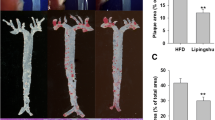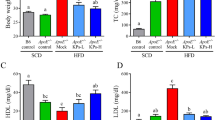Abstract
Objective
To observe the effects of red yeast rice (RYR) on blood lipid levels, aortic atherosclerosis (AS), and plaque stability in apolipoprotein E gene knockout (ApoE-/-) mice.
Methods
Twenty-four ApoE-/- mice were fed with a high-fat diet starting from 6 weeks of age. Mice were randomized into three groups (n = 8 in each group): model group (ApoE-/- group), RYR group (ApoE-/- + RYR group), and simvastatin group (ApoE-/- + simvastatin group). Eight 6-week-old C57BL/6 mice were assigned as the control group and fed with a basic diet. After 36 weeks, plasma lipids and inflflammatory factors were measured. Aortic atherosclerotic lesions by microscope, scanning electron microscope and transmission electron microscope were observed. Plasma levels of interleukin-6 (IL-6) and tumor necrosis factor-α (TNF-α) were measured with enzyme-linked immunosorbent assay. The level of high sensitivity C-reaction protein (Hs-CRP) was detected by the scattering immunoturbidimetric assay. Protein expression of matrix metalloproteinase-9 (MMP-9) and nuclear factor κB (NF-κB) in aorta were tested by immunohistochemistry.
Results
Compared with the model group, treatment with RYR significantly decreased the levels of total cholesterol, triglyceride, low-density lipoprotein cholesterol, lipoprotein (a), and apolipoprotein B100 in ApoE-/- mice (P<0.01). Compared with the model group, treatment with RYR decreased the levels of Hs-CRP, IL-6, and TNF-α (P<0.01). RYR also reduced the protein levels of NF-κB and MMP-9 of the aorta.
Conclusions
RYR has the anti-atherosclerotic and stabilizing unstable plaque effects. The mechanism might be related to the inflflammatory signaling pathways.
Similar content being viewed by others
References
Ross R. Atherosclerosis—an inflammatory disease. N Engl J Med 1999;340:115–126.
Farzadfar F, Finucane MM, Danaei G, Pelizzari PM, Cowan MJ, Paciorek CJ, et al. National, regional, and global trends in serum total cholesterol since 1980: systematic analysis of health examination surveys and epidemiological studies with 321 country-years and 3.0 million participants. Lancet 2011;377:578–586.
Smith SC Jr, Benjamin EJ, Bonow RO, Braun LT, Creager MA, Franklin BA, et al. AHA/ACCF secondary prevention and risk reduction therapy for patients with coronary and other atherosclerotic vascular disease: 2011 update: a guideline from the American Heart Association and American College of Cardiology Foundation. Circulation 2011;124:2458–2473.
Gotto AM Jr. Statins, cardiovascular disease, and drug safety. Am J Cardiol 2006;97:3C-5C.
Armitage J. The safety of statins in clinical practice. Lancet 2007;370:1781–1790.
Mancini GB, Tashakkor AY, Baker S, Bergeron J, Fitchett D, Frohlich J, et al. Diagnosis, prevention, and management of statin adverse effects and intolerance: Canadian Working Group Consensus update. Can J Cardiol 2013;29:1553–1568.
Liu Y, Chen KJ. Atherosclerosis, vascular aging and therapeutic strategies. Chin J Integr Med 2012;18:83–87.
Heber D, Lembertas A, Lu QY, Bowerman S, Go VL. An analysis of nine proprietary Chinese red yeast rice dietary supplements: implications of variability in chemical profile and contents. J Altern Complement Med 2001;7:133–139.
Ma J, Li Y, Ye Q, Li J, Hua Y, Ju D, et al. Constituents of red yeast rice, a traditional Chinese food and medicine. J Agric Food Chem 2000;48:5220–5225.
Fung WT, Subramaniam G, Lee J, Loh HM, Leung PH. Assessment of extracts from red yeast rice for herb-drug interaction by in vitro and in vivo assays. Sci Rep 2012;2:298.
Chen ZF, Zhao B, Tang XY, Li W, Zhu LL, Tang CS, et al. Hydrogen sulfide regulates vascular endoplasmic reticulum stress in apolipoprotein E knockout mice. Chin Med J 2011;124:3460–3467.
Ross SM. Red yeast rice: efficacy and tolerability of Monascus purpureus yeast, for treatment of hyperlipidemia in patients with statin-associated myalgias. Holist Nurs Pract 2012;26:173–175.
Venero CV, Venero JV, Wortham DC, Thompson PD. Lipidlowering efficacy of red yeast rice in a population intolerant to statins. Am J Cardiol 2010;105:664–666.
Liu J, Zhang J, Shi Y, Grimsgaard S, Alraek T, Fonnebo V. Chinese red yeast rice (Monascus purpureus) for primary hyperlipidemia: a meta-analysis of randomized controlled trials. Chin Med 2006;1:4.
Cao C, Zhu Y, Chen W, Li L, Qi Y, Wang X, et al. IKKepsilon knockout prevents high fat diet induced arterial atherosclerosis and NF-kappaB signaling in mice. PLoS One 2013;8:e64930.
Hamaguchi M, Seno T, Yamamoto A, Kohno M, Kadoya M, Ishino H, et al. Loxoprofen sodium, a non-selective NSAID, reduces atherosclerosis in mice by reducing inflammation. J Clin Biochem Nutr 2010;47:138–147.
Paigen B, Morrow A, Holmes PA, Mitchell D, Williams RA. Quantitative assessment of atherosclerotic lesions in mice. Atherosclerosis 1987;68:231–240.
Liu X, Zhao G, Yan Y, Bao L, Chen B, Qi R. Ginkgolide B reduces atherogenesis and vascular inflammation in ApoE(-/-) mice. PLoS One 2012;7:e36237.
Ibrahim OM, Dogru M, Matsumoto Y, Igarashi A, Kojima T, Wakamatsu TH, et al. Oxidative stress induced age dependent meibomian gland dysfunction in Cu, Zn-superoxide dismutase-1 (Sod1) knockout mice. PLoS One 2014;9:e99328.
Jawien J, Toton-Zuranska J, Gajda M, Niepsuj A, Gebska A, Kus K, et al. Angiotensin-(1-7) receptor Mas agonist ameliorates progress of atherosclerosis in apoE-knockout mice. J Physiol Pharmacol 2012;63:77–85.
Liu LT, Guo G, Wu M, Zhang WG. The progress of the research on cardiovascular effects and acting mechanism of polydatin. Chine J Integr Med 2012;18:714–719.
Yang CW, Mousa SA. The effect of red yeast rice (Monascus purpureus) in dyslipidemia and other disorders. Complement Ther Med 2012;20:466–474.
Childress L, Gay A, Zargar A, Ito MK. Review of red yeast rice content and current food and drug administration oversight. J Clin Lipidol 2013;7:117–122.
Dabek J, Kulach A, Gasior Z. Nuclear factor kappa-lightchain-enhancer of activated B cells (NF-kappaB): a new potential therapeutic target in atherosclerosis? Pharmacol Rep 2010;62:778–783.
Galis ZS, Sukhova GK, Lark MW, Libby P. Increased expression of matrix metalloproteinases and matrix degrading activity in vulnerable regions of human atherosclerotic plaques. J Clin Invest 1994;94:2493–2503.
Heo SH, Cho CH, Kim HO, Jo YH, Yoon KS, Lee JH, et al. Plaque rupture is a determinant of vascular events in carotid artery atherosclerotic disease: involvement of matrix metalloproteinases 2 and 9. J Clin Neurol 2011;7:69–76.
Author information
Authors and Affiliations
Corresponding author
Additional information
Supported by the National Natural Science Foundation of China (No. 81102721, No. 81573821 and No. 81202809), Beijing Natural Science Foundation (No. 7172185), Technologic Item of State Administration of Traditional Chinese Medicine (No. 04-05LP30, JDZX2015262), Chinese National Scientific Fund for Post-doctor (No. 2015M570220), Its Special Aid Item (No. 2016T90194) and the Key Technologies R & D Program of Shandong Province, China (No. 2010 GSF 10289)
Conflict of Interests The authors declare that they don't have any conflict of interest.
Author Contributions Wu M was responsible for conception and design of the study, carried out the search, performed data analysis, and drafted the manuscript. Zhang WG and Liu LT performed data extraction and participated in conception and design of the review, and critically revised the manuscript.
Rights and permissions
About this article
Cite this article
Wu, M., Zhang, Wg. & Liu, Lt. Red yeast rice prevents atherosclerosis through regulating inflammatory signaling pathways. Chin. J. Integr. Med. 23, 689–695 (2017). https://doi.org/10.1007/s11655-017-2416-x
Received:
Published:
Issue Date:
DOI: https://doi.org/10.1007/s11655-017-2416-x




